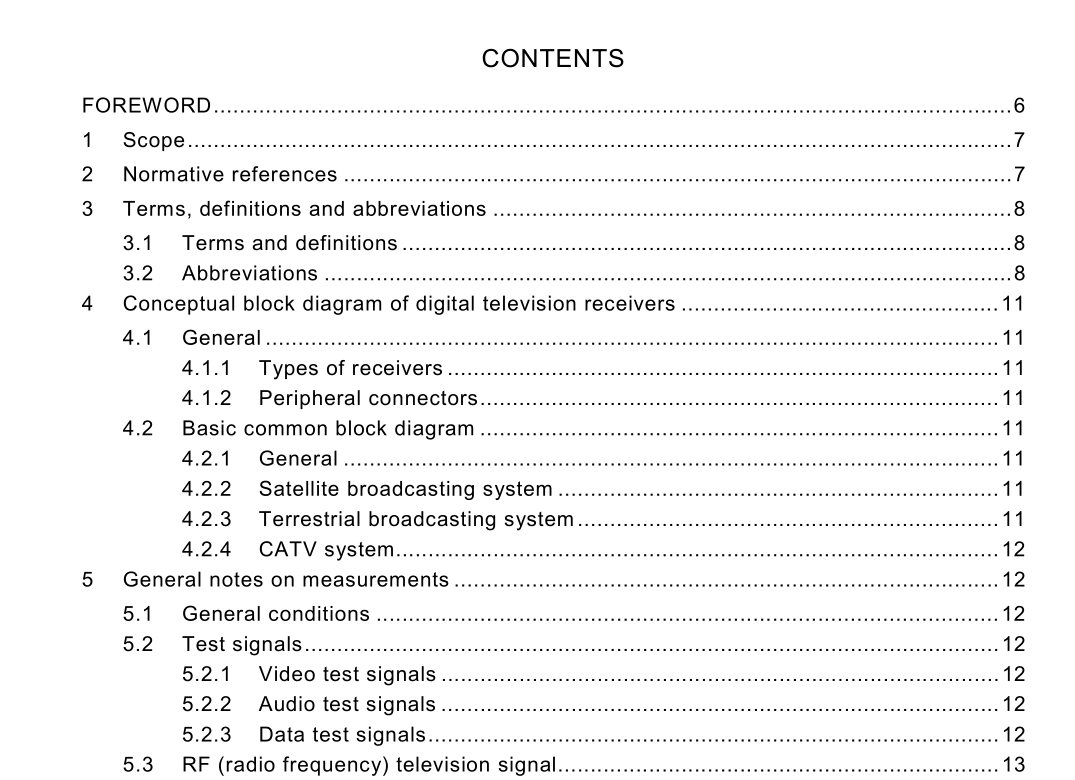IEC 62028 pdf download

IEC 62028 pdf download.General methods of measurement for digital television receivers
1 Scope
IEC 62028 deals with the standard conditions and methods of measurement on digital television receivers which receive digital television broadcast transmissions. IEC 62028 deals with the determination of performance and allows the comparison of equipment by listing the characteristics which are useful for specifications and by laying down uniform measuring methods of these characteristics. Performance requirements are not specified, since they are specified by other international, regional or domestic standards for the systems. It does not include the measurements specific to the transmission system, such as; • measurements on receivers for satellite transmission systems, • measurements on receivers for terrestrial transmission systems, • measurements on receivers for cable transmission systems, • measurements specific to sound channels, and • measurements specific to data channels. IEC 62028 does not include methods of measurement on outdoor units and antennas for satellite reception, for which reference is required to other appropriate IEC standards. IEC 62028 does not deal with general safety matters, for which reference is required to IEC 60065, or other appropriate IEC safety standards, nor with radiation and immunity, which will be dealt with by CISPR.
4 Conceptual block diagram of digital television receivers
4.1 General 4.1.1 Types of receivers Digital television receivers are usually designed to be capable of receiving digital television signals in a variety of ways. Examples are direct off-air reception or reception via cabled network in the VHF/UHF bands, and from satellite broadcasts in conjunction with an outdoor unit and a DBS tuner. Further digital signals can be delivered by the PSTN or ISDN. The signal will usually include information on the service supplied. A return path can be present for interactive TV applications. For non-broadcast signals, the receiver may be used as a monitor to display pre-recorded video or home movies. The methods of measurement described in this standard take into account various options. 4.1.2 Peripheral connectors Most receivers are provided with connectors for the interface with audio and video signals. Examples are the 21-pin connector described in IEC 60933-1 and IEC 60933-2 and the Y/C connector described in IEC 60933-5. An example for a digital interface is described in the IEC 61883 series and an example for an analogue interface is described in IEC 61880.4.2 Basic common block diagram 4.2.1 General The basic common conceptual block diagram of digital television broadcasting system is shown in figure 1. After audio and video signals are converted from analogue to digital, they are compressed. Data signals, which might include EPG (Electronic Program Guide), SI (Service Information), teletext program, etc., are multiplexed with compressed audio and video signals. After channel coding, the TS is modulated and transmitted via satellite, terrestrial, or cable. In digital television receivers, the transmitted signal is demodulated and sent to the error correction block. After error correction, audio, video, and data signals are demultiplexed, and audio and video signals are decompressed respectively. Audio and video signals are sent to a conventional (analogue) TV receiver (through the peritelevision socket) or to a display and loud speakers, and the data signal is sent to a conventional (analogue) TV receiver (through the peritelevision socket) or to data equipment. 4.2.2 Satellite broadcasting system When the digital television signal is transmitted via satellite, BPSK, QPSK and TC-8PSK modulation formats are used. 4.2.3 Terrestrial broadcasting system COFDM, band-segmented OFDM and 8VSB modulation formats are used in the terrestrial broadcasting system.









